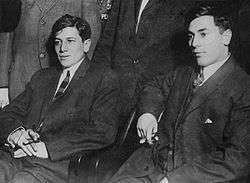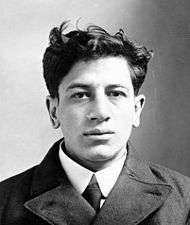Harry Horowitz
| Harry "Gyp the Blood" Horowitz | |
|---|---|
|
Police mugshot of Horowitz in 1912 | |
| Born |
c. 1889 New York City, New York |
| Died |
April 13, 1914 Sing Sing Prison, Ossining, New York, U.S. |
| Cause of death | Execution by electric chair |
| Resting place | Mount Zion Cemetery, Queens |
| Nationality | American |
| Other names | Gyp the Blood; Levy; Jones[1] |
| Religion | Jewish |
| Criminal charge | Murder |
| Spouse(s) | Lillian Horowitz |
| Conviction(s) | Burglary, robbery, murder |
Harry Horowitz (c. 1889 – April 13, 1914), also known as "Gyp the Blood",[2] was an American underworld figure and a leader of the Lenox Avenue Gang in New York City.
Biography
Harry Horowitz was born on the Lower East Side of Manhattan c. 1889, to Orthodox Jewish parents. He was a slight figure, standing just under 5 feet 5 inches (1.65 m) and weighing 140 pounds (64 kg).[1] but extraordinarily strong. He bragged that to win a $2 bet, he broke a man's back in three places.[3] He served prison terms for burglary and robbery.[1]
New York City Judge Franklin C. Hoyt later recalled:
Three or four years ago, when I was sitting in special sessions, my associates and I had occasion to sentence a young man who had been found guilty of petty larceny. In pronouncing sentence I said: 'I am convinced from the evidence that has been brought out here that you are lacking in moral sense, that at the end of your prison term you will go out and commit more. It is a wrong to the community that you should be so set at liberty, and it is a wrong to you that you should be allowed to follow your course without restraint.'
One of the parents of my young man—he was barely twenty-one—told me tearfully that he was a good boy, the best of boys, but that he had been in bad company and tempted too far. Before he had served out his term his parent came to me again to tell me that now he had promised to reform and how well he was doing. I still had my doubts. —The Outlook, February 8, 1913.[4]
Rosenthal murder

On July 16, 1912,[5] he and three accomplices murdered gambler Herman Rosenthal outside the Hotel Metropole. The four shot Rosenthal to death. Two of the killers, Jacob Seidenshner (aka "Whitey Lewis"),[6] and Francisco "Frank" Cirofici (aka "Dago Frank") were arrested immediately after the killing, along with Charles Becker, a detective from the New York Police Department who was suspected of being a business partner of Rosenthal,[7] but Horowitz and the fourth gunman, "Lefty" Louis Rosenberg, were not. There was a massive hunt for the missing two, who were found and arrested on September 14, 1912, in an apartment in Glendale, Queens, where they had been hiding for months.[8]
During the trial, the three defendants claimed Rosenthal was murdered by someone known only as "Itsky". Defense attorney Charles G.F. Wahle said Horowitz was no saint but was not guilty, telling the jury: "He has never been known as 'Gyp the Blood,' but only as 'Gyp.' He is the victim of evil companions. He is a cheat and a sharper and has been convicted as such. It would be futile for us to deny this, but he is not a murderer."[9]
Horowitz, Rosenberg, Seidenshner and Cirofici were convicted in November 1912 and sentenced to death.[10] There were rumors that an attempt to rescue the criminals would be made during their transfer to Sing Sing Prison after the trial. Sheriff Julius Harburger, responsible for transporting the prisoners, received a number of anonymous notes, among which was one that said:
Sheriff Harburger—watch out when you take Gyp and his gang up the long steps at Ossining. Kitty the Second and his bunch will be there hiding in the rocks to shoot you up and rescue them. A WELL-WISHER.[11]
Their case before the New York Court of Appeals was denied in February 1914, although Becker was granted a new trial.[12] They produced additional witnesses on April 11, 1914, who swore to their innocence, but New York Supreme Court Justice Goff did not find them credible.[13]
Horowitz gave a last statement to the press on April 13, 1914, stating:
We all knew that the result was decided against us just as soon as we heard Justice Goff was in the case. We had given up expecting mercy either from Justice Goff or District Attorney Whitman.[14]
Two hours before the execution, Cirofici gave a statement admitting he lied on the stand during the trial. Cirofici made the statement in the presence of the warden, the superintendent of the State Prison Department, and his mother and sister, regarding Rosenthal's murder. He stated that he was not present during the murder, but that it was committed by Rosenberg, Horowitz and informant Harry Vallon, who testified for the state during the trial.[15]
On April 13, 1914, Horowitz was put to death in the electric chair, along with Rosenberg, Seidenshner and Cirofici.[16] The next year, Becker also was executed for his part in the murder.[17]
In popular culture
A character nicknamed Gyp the Blood appears in a book by Kevin Baker, where a fictionalized version of events from Harry Horowitz's life play out.
References
- 1 2 3 "Three of the Men Hunted as Rosenthal's Slayers". The New York Times. July 25, 1912. p. 2.
- ↑ "Sullivan was there When Rosenthal Shot Down". The New York Times. July 27, 1912. p. 1.
- ↑ Robert A. Rockaway (2000). But He was Good to His Mother: The Lives and Crimes of Jewish Gangsters. Gefen Publishing House. pp. 110–111. ISBN 978-965-229-249-0.
- ↑ "The Mental Hygiene Movement: A National Campaign Against Insanity". The Outlook. February 8, 1913. p. 312.
- ↑ "Gambler Who Defied Police is Shot Dead: Rosenthal Killed in Front of Hotel Metropole Early this Morning". The New York Times. July 16, 1912. p. 1.
- ↑ "The People of The State of New York, Respondent, v. Jacob Seidenshner, Frank Cirofici, Louis Rosenberg and Harry Horowitz, Appellants.". Reports of Cases Decided in the Court of Appeals of the State of New York, Volume 210. New York (State) Court of Appeals.
The defendants were named in the indictment as Frank Muller, alias Whitey Louis, alias Whitey Jack, alias Louis Seidenschue, alias Jack Biegel .... It was subsequently ascertained that the true name of Frank Muller was Jacob Seidenshner.
- ↑ "Civic Bodies Find Police are Lax". The New York Times. July 31, 1912. p. 3.
- ↑ "'Gyp' and 'Lefty' Caught at Last, Here in Town". The New York Times. September 15, 1912. p. 1.
- ↑ "Gunmen Put Crime On Unknown 'Itsky'". The New York Times. November 14, 1912. p. 1.
- ↑ "Gunmen Ask Delay: Want Argument on their Appeals Put Over Till October". The New York Times. June 6, 1913. p. 1.
- ↑ "Gunmen Hear To-Day The Death Sentence; Sheriff Will Take Them to Sing Sing at Once, Guarding Against Attack". The New York Times. November 26, 1912. p. 24.
- ↑ "Becker Wins New Trial on Errors; Gunmen to Die". The New York Times. February 25, 1914. p. 1.
- ↑ "Fresh Testimony not Worthy of Credence, Says Justice Goff". The New York Times. April 12, 1914. p. 1.
- ↑ "Last Statements Made by Three of the Gunmen". The New York Times. April 13, 1914. p. 1.
- ↑ "Statement by Cirofici at Sing Sing Two Hours Before Execution". The New York Times. April 14, 1914. p. 1.
- ↑ "Glynn Silent on Confession: Governor also Refuses to Discuss the Executions". The New York Times. April 14, 1914. p. 1.
- ↑ "Egoism of Becker Led Him to Murder: Gave His Life as the Price He Had Put on Place and Power Among His Fellows". The New York Times. July 31, 1915. p. 3.
Further reading
- Dash, Mike. Satan's Circus: Murder, Vice, Police Corruption and New York's Trial of the Century, Crown, New York, 2006
- Gustavus, Myers. The History of Tammany Hall. New York: Boni & Liveright, 1917.
- Joselit, Jenna Weissman. Our Gang: Jewish Crime and the New York Jewish Community, 1900-1940. Bloomington: Indiana University Press, 1983. ISBN 0-253-15845-1
- Katcher, Leo. The Big Bankroll: The Life and Times of Arnold Rothstein. New York: Da Capo Press, 1994. ISBN 0-306-80565-0
- Kohn, George C. Dictionary of Culprits and Criminals. Metuchen, New Jersey: Scarecrow Press, 1986.
- Lardner, James and Thomas Reppetto. NYPD: A City and Its Police. New York: Henry Holt & Co., 2000. ISBN 978-0-8050-6737-8
- Pietrusza, David. Rothstein: The Life, Times, and Murder of the Criminal Genius Who Fixed the 1919 World Series. New York: Carroll & Graf Publishers, 2003. ISBN 0-7867-1250-3
- Reeve, Arthur Benjamin. The Golden Age of Crime. New York: Mohawk Press, 1937.
- Tosches, Nick. King of the Jews: The Greatest Mob Story Never Told. New York: Harper Perennial, 2006.
External links
- Harry Horowitz from the Library of Congress at Flickr Commons
- Harry Horowitz at Find a Grave
- The "Killer Cop" and the Tombs
